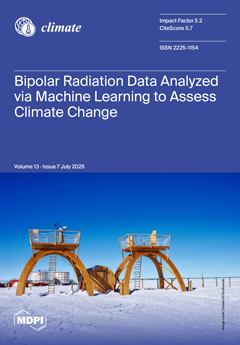Rain attenuation of radio waves with frequencies above 10 GHz causes a serious problem in wireless communications. For wireless systems design, highly accurate methods for estimating the magnitude of attenuation have long been studied. ITU-R recommends a calculation method for rain attenuation using
[...] Read more.
Rain attenuation of radio waves with frequencies above 10 GHz causes a serious problem in wireless communications. For wireless systems design, highly accurate methods for estimating the magnitude of attenuation have long been studied. ITU-R recommends a calculation method for rain attenuation using
R0.01, the 1 min rainfall rate that is exceeded for 0.01% of an average year. Accordingly, an
R0.01 database suitable for this calculation has been constructed. In recent years, global warming has emerged as an important climatological issue. If the predicted rise in temperatures associated with global warming induces a significant effect on rainfall characteristics, the existing
R0.01 database will need to be revised. However, there is currently no information for quantitatively evaluating the likely long-term change in
R0.01. In our previous study, the long-term trend in annual maximum values for 1-day, 1 h, and 10 min rainfall in Japan was estimated from a large amount of meteorological data and a 95% confidence interval approach was used to identify an increasing trend of more than 10% over approximately 100 years. In this paper, we investigate the long-term trend in greater detail using non-linear approximations for three types of rainfall and adopt the Akaike Information Criterion to determine the optimal order of the non-linear approximation. The future trend of
R0.01 is then estimated based on the long-term change in annual maximum 1 h rainfall, exploiting the strong correlation between long-term average annual maximum 1 h rainfall and
R0.01.
Full article





